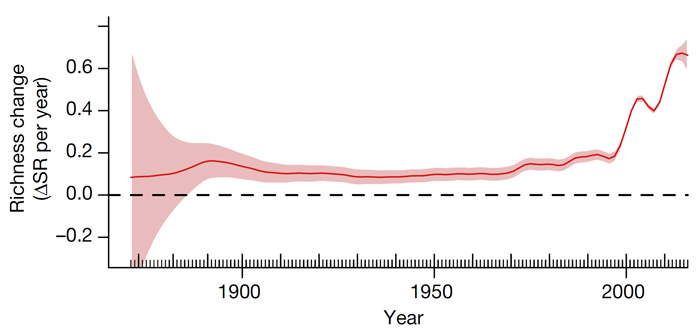| Tweet | Follow @co2science |
Paper Reviewed
Steinbauer, M.J., Grytnes, J.-A., Jurasinski, G., Kulonen, A., Lenoir, J., Pauli, H., Rixen, C., Winkler, M., Bardy-Durchhalter, M., Barni, E., Bjorkman, A.D., Breiner, F.T., Burg, S., Czortek, P., Dawes, M.A., Delimat, A., Dullinger, S., Erschbamer, B., Felde, V.A., Fernández-Arberas, O., Fossheim, K.F., Gómez-García, D., Georges, D., Grindrud, E.T., Haider, S., Haugum, S.V., Henriksen, H., Herreros, M.J., Jaroszewicz, B., Jaroszynska, F., Kanka, R., Kapfer, J., Klanderud, K., Kühn, I., Lamprecht, A., Matteodo, M., Morra di Cella, U., Normand, S., Odland, A., Olsen, S.L., Palacio, S., Petey, M., Piscová, V., Sedlakova, B., Steinbauer, K., Stöckli, V., Svenning, J.-C., Teppa, G., Theurillat, J.-P., Vittoz, P., Woodin, S.J., Zimmermann, N.E. and Wipf, S. 2018. Accelerated increase in plant species richness on mountain summits is linked to warming. Nature 556: 231-234.
One of the great horror stories associated with predictions of CO2-induced global warming is that the warming (if it occurs) will be so fast and furious that many species of plants will not be able to migrate towards cooler regions -- poleward in latitude, or upward in elevation -- at rates that are rapid enough to avoid extinction.
Over the past two decades we have (1) reviewed several papers (see Extinction (Migrating Plants) and Extinction (Stationary Plants)), (2) published a major report and (3) produced a video documentary examining this claim.
Through these efforts we have learned that it is easy to make long-term predictions; but to substantiate them with facts is an entirely different matter. And even when the facts are largely in hand, one can still be blinded by preconceived ideas that make it difficult to comprehend the real meaning of what has been discovered. So it is with the specter of species extinction that hovers over the global warming debate. The vast majority of people who have studied the subject have not understood some of the issue's most basic elements; and they have consequently drawn conclusions that are not aligned with reality.
Proponents of what we shall call the CO2-induced global warming extinction hypothesis seem to be totally unaware of the fact that atmospheric CO2 enrichment tends to ameliorate the deleterious effects of rising temperatures on earth's vegetation. They appear not to know that more CO2 in the air enables plants to grow better at nearly all temperatures, but especially at higher temperatures. They feign ignorance of the knowledge (or truly do not know) that elevated CO2 boosts the optimum temperature at which plants grow best, and that it raises the upper-limiting temperature above which they experience death, making them much more resistant to heat stress.
The end result of these facts is that if the atmosphere's temperature and CO2 concentration rise together, plants are able to successfully adapt to the rising temperature, and they experience no ill effects of the warming. Under such conditions, plants living near the heat-limited boundaries of their ranges do not experience an impetus to migrate poleward or upward towards cooler regions of the globe. At the other end of the temperature spectrum, however, plants living near the cold-limited boundaries of their ranges are empowered to extend their ranges into areas where the temperature was previously too low for them to survive. And as they move into those once-forbidden areas, they actually expand their ranges, overlapping the similarly-expanding ranges of other plants and thereby increasing local plant biodiversity.
Vindication of our thesis has been gaining momentum year by year, as scientists have published papers examining this topic using real world data (see the many reviews we have archived in our Subject Index under the following headings: Alpine Ecosystems, Extinction and Range Expansion).
The latest such work comes from the 53-member research team of Steinbauer et al. (2018). Publishing in the journal Nature, this new group of scientists analyzed a massive continent-wide dataset of repeated plant surveys from 302 mountain summits across Europe dating all the way back to 1871 in an effort to "assess the temporal trajectory of mountain biodiversity changes." Vegetation surveys were conducted predominately on the uppermost 10 m of elevation on each summit during the summer, with each summit being resurveyed between one to six times between 1871 and 2016, for a total of 698 surveys over the period of study. Such surveys, in the words of the authors, were "optimal ... for detecting changes in plant species richness over time."
So what did the records show? Has the global warming of the past century and a half driven plants in such mountain top ecosystems toward extinction?
In a word, no!
Contrary to climate alarmist contentions and model-based predictions, Steinbauer et al. report there has been "a continent-wide acceleration in the rate of increase in plant species richness, with five times as much species enrichment between 2007 and 2016 as fifty years ago, between 1957 and 1966" (see Figure 1 below). What is more, they note that this incredible trend of increasing biodiversity was "consistent across all [continental regions], with no single region showing the opposite pattern."
Nevertheless, despite such good news rooted in real-world observations, the team of researchers just can't seem to bring themselves to reject the CO2-induced global warming extinction hypothesis. Appearing to be still blinded by their preconceived ideas, they opine that "accelerating plant species richness increases are expected to be a transient phenomenon that hides the accumulation of a so-called extinction debt," where "a rapid loss of alpine-nival species may occur under accelerated global warming."
So sad!

Figure 1. Rate of change in species richness (mean, red line). The shaded grey area represents ± s.e.m. Source: Steinbauer et al. (2018).




